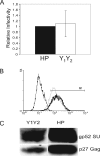An immunoreceptor tyrosine activation motif in the mouse mammary tumor virus envelope protein plays a role in virus-induced mammary tumors
- PMID: 16940512
- PMCID: PMC1563925
- DOI: 10.1128/JVI.00788-06
An immunoreceptor tyrosine activation motif in the mouse mammary tumor virus envelope protein plays a role in virus-induced mammary tumors
Erratum in
- J Virol. 2007 Nov;81(22):12718
Abstract
Mouse mammary tumor virus (MMTV) induces breast cancer with almost 100% efficiency in susceptible strains through insertional activation of protooncogenes, such as members of the wnt and fibroblast growth factor (fgf) families. We previously showed that expression of the MMTV envelope protein (Env) in normal immortalized mammary epithelial cells grown in three-dimensional cultures caused their morphological transformation, and that this phenotype depended on an immunoreceptor tyrosine-based activation motif (ITAM) present in Env and signaling through the Syk tyrosine kinase (E. Katz, M. H. Lareef, J. C. Rassa, S. M. Grande, L. B. King, J. Russo, S. R. Ross, and J. G. Monroe, J. Exp. Med. 201:431-439, 2005). Here, we examined the role of the Env protein in virus-induced mammary tumorigenesis in vivo. Similar to the effect seen in vitro, Env expression in the mammary glands of transgenic mice bearing either full-length wild-type provirus or only Env transgenes showed increased lobuloalveolar budding. Introduction of the ITAM mutation into the env of an infectious, replication-competent MMTV or into MMTV/murine leukemia virus pseudotypes had no effect on incorporation of Env into virus particles or on in vitro infectivity. Moreover, replication-competent MMTV bearing the ITAM mutation in Env infected lymphoid and mammary tissue at the same level as wild-type MMTV and was transmitted through milk. However, mammary tumor induction was greatly attenuated, and the pattern of oncogene activation was altered. Taken together, these studies indicate that the MMTV Env protein participates in mammary epithelial cell transformation in vivo and that this requires a functional ITAM in the envelope protein.
Figures





Similar articles
-
Mouse mammary tumor virus suppresses apoptosis of mammary epithelial cells through ITAM-mediated signaling.J Virol. 2012 Dec;86(24):13232-40. doi: 10.1128/JVI.02029-12. Epub 2012 Sep 26. J Virol. 2012. PMID: 23015704 Free PMC article.
-
MMTV Env encodes an ITAM responsible for transformation of mammary epithelial cells in three-dimensional culture.J Exp Med. 2005 Feb 7;201(3):431-9. doi: 10.1084/jem.20041471. Epub 2005 Jan 31. J Exp Med. 2005. PMID: 15684322 Free PMC article.
-
Mammary cancer stages in BALB/cV mice: mouse mammary tumor virus expression and virus-host interactions.J Natl Cancer Inst. 1987 Aug;79(2):323-35. J Natl Cancer Inst. 1987. PMID: 3037152
-
MMTV infectious cycle and the contribution of virus-encoded proteins to transformation of mammary tissue.J Mammary Gland Biol Neoplasia. 2008 Sep;13(3):299-307. doi: 10.1007/s10911-008-9090-8. Epub 2008 Jul 26. J Mammary Gland Biol Neoplasia. 2008. PMID: 18661104 Free PMC article. Review.
-
Stem cells and mammary cancer in mice.Stem Cell Rev. 2005;1(3):215-23. doi: 10.1385/SCR:1:3:215. Stem Cell Rev. 2005. PMID: 17142858 Review.
Cited by
-
Lessons Learned from Mouse Mammary Tumor Virus in Animal Models.ILAR J. 2016;57(1):12-23. doi: 10.1093/ilar/ilv044. ILAR J. 2016. PMID: 27034391 Free PMC article.
-
Late developing mammary tumors and hyperplasia induced by a low-oncogenic variant of mouse mammary tumor virus (MMTV) express genes identical to those induced by canonical MMTV.Mol Cancer. 2013 Jul 18;12:79. doi: 10.1186/1476-4598-12-79. Mol Cancer. 2013. PMID: 23866257 Free PMC article.
-
Global Down-regulation of Gene Expression Induced by Mouse Mammary Tumor Virus (MMTV) in Normal Mammary Epithelial Cells.Viruses. 2023 May 2;15(5):1110. doi: 10.3390/v15051110. Viruses. 2023. PMID: 37243196 Free PMC article.
-
An ITAM in a nonenveloped virus regulates activation of NF-κB, induction of beta interferon, and viral spread.J Virol. 2014 Mar;88(5):2572-83. doi: 10.1128/JVI.02573-13. Epub 2013 Dec 18. J Virol. 2014. PMID: 24352448 Free PMC article.
-
Mouse mammary tumor virus suppresses apoptosis of mammary epithelial cells through ITAM-mediated signaling.J Virol. 2012 Dec;86(24):13232-40. doi: 10.1128/JVI.02029-12. Epub 2012 Sep 26. J Virol. 2012. PMID: 23015704 Free PMC article.
References
-
- Beaufils, P., D. Choquet, R. Mamoun, and B. Malissen. 1993. The (XXL/I)2 motif found in the cytoplasmic segments of the bovine leukemia virus envelope protein and Epstein-Barr virus latent membrane protein 2A can elicit early and late lymphocyte activation events. EMBO J. 12:5105-5112. - PMC - PubMed
-
- Callahan, R., and G. H. Smith. 2000. MMTV-induced mammary tumorigenesis: gene discovery, progression to malignancy and cellular pathways. Oncogene 19:992-1001. - PubMed
-
- Cantor, G. H. 1996. A potential proline-rich motif upstream of the immunoreceptor tyrosine-based activation motif in bovine leukemia virus gp30, Epstein-Barr virus LMP2A, herpesvirus papio LMP2A, and African horsesickness virus VP7. Virology 220:265-266. - PubMed
Publication types
MeSH terms
Substances
Grants and funding
LinkOut - more resources
Full Text Sources
Miscellaneous

